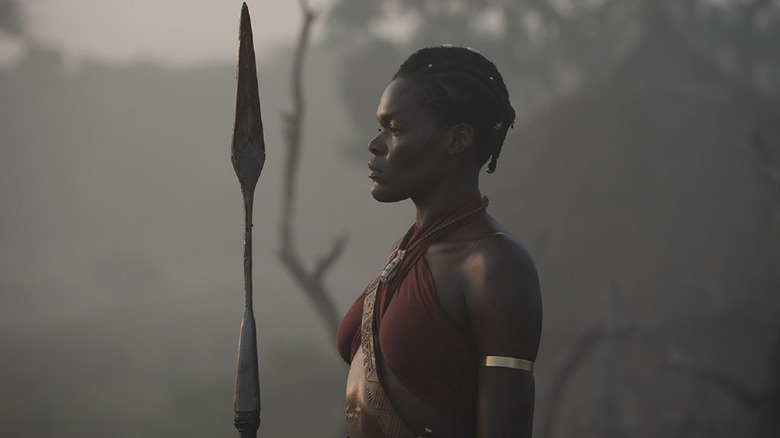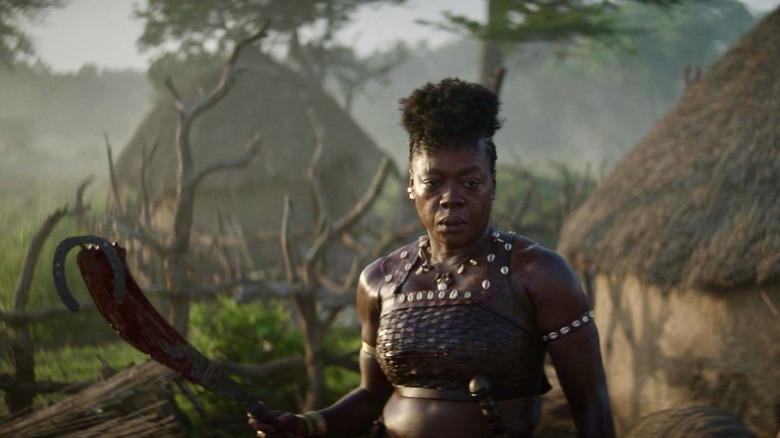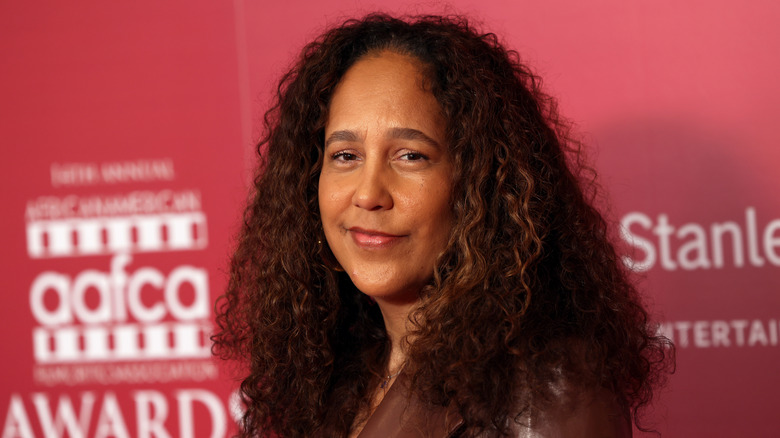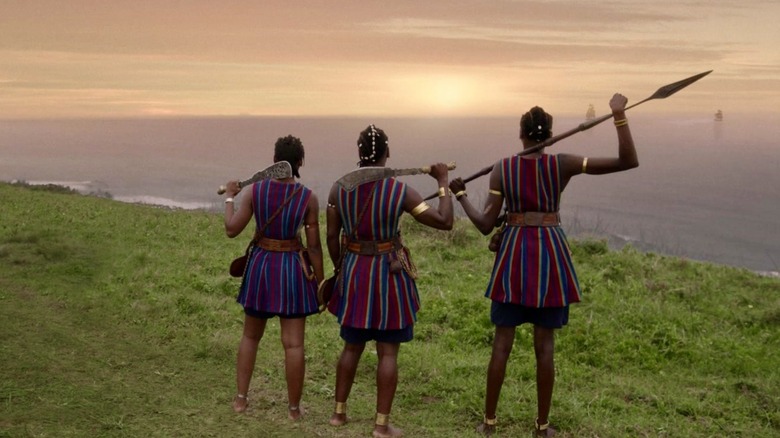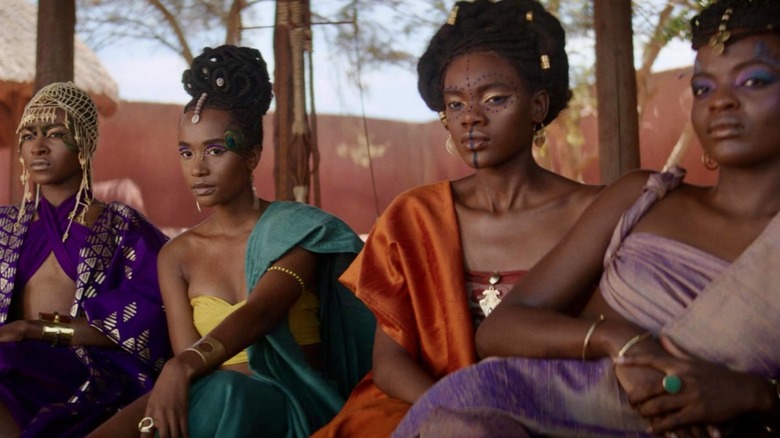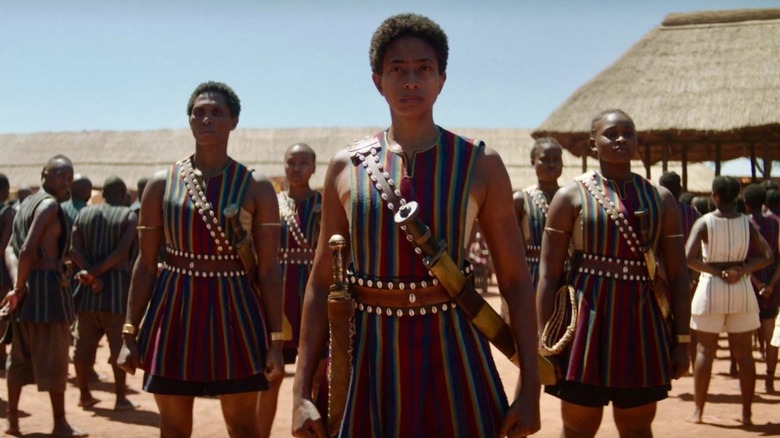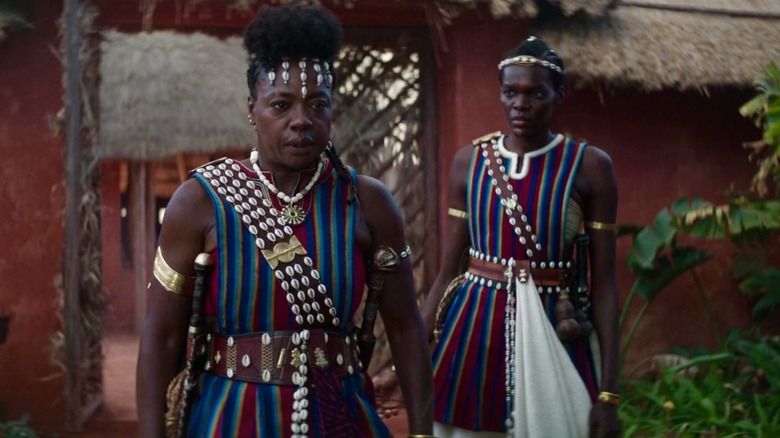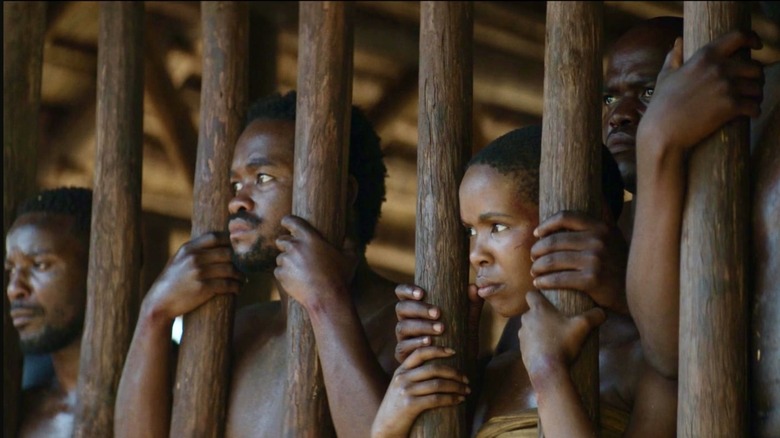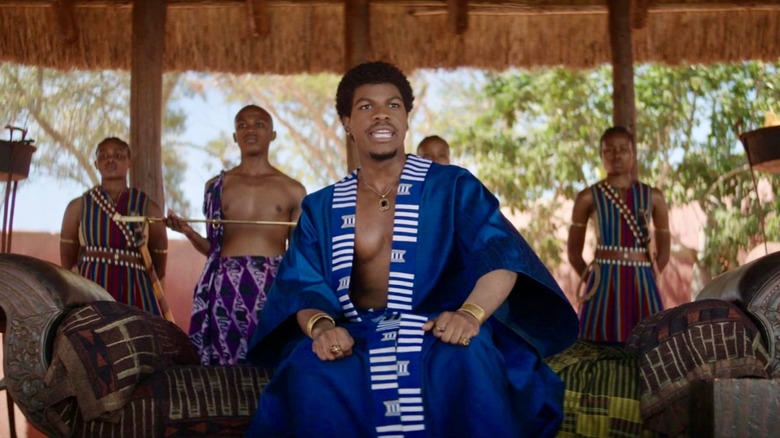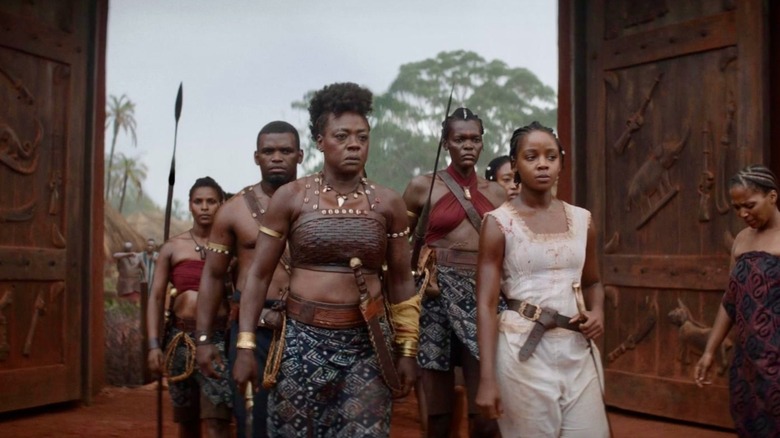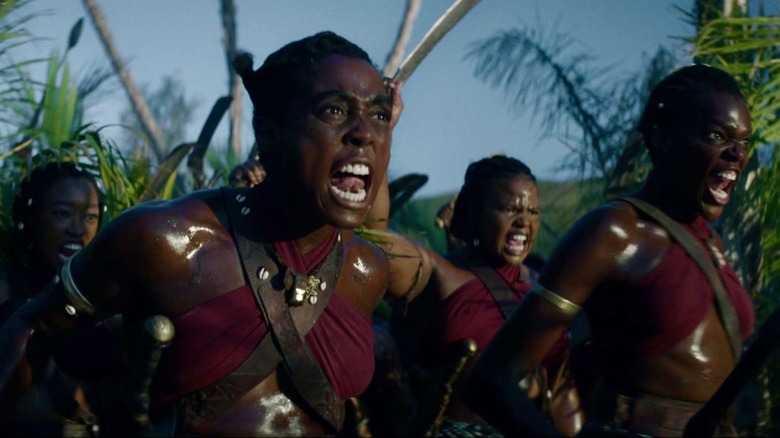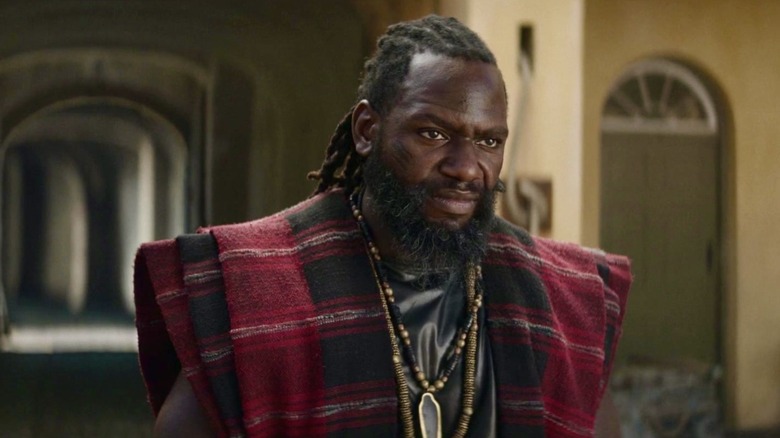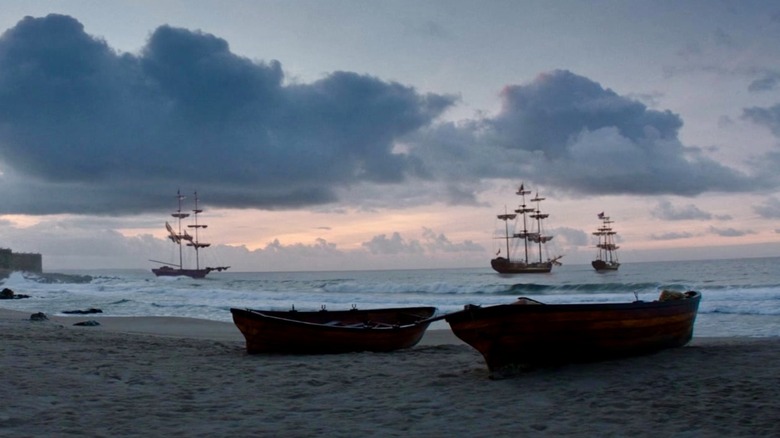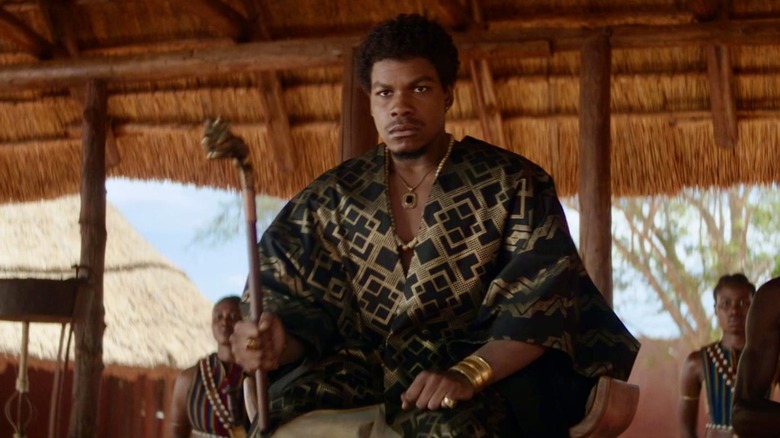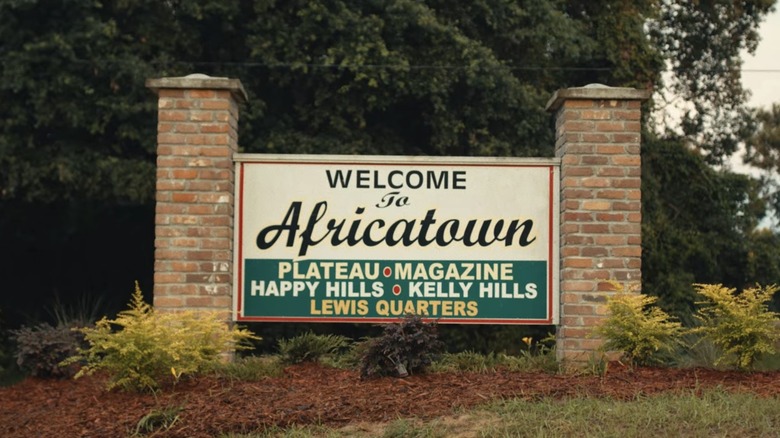Everything The Woman King Gets Wrong About The True Story
Historical epics are typically about men who did something historically noteworthy, but Gina Prince-Bythewood's "The Woman King" is inspired by the Agojie, an elite group of female soldiers who fought for the West African Kingdom of Dahomey in the 18th and 19th centuries. This historical drama follows Nawi (Thuso Mbedu), a young woman given to King Ghezo (John Boyega) after her parents cannot match her with a husband because of her spirited nature.
Nawi and a group of captives train under General Nanisca (Viola Davis), becoming members of the fearsome group of woman warriors known to Europeans as Dahomey's Black Amazons. The Agojie fight the Oyo Empire for Dahomey's independence and to put an end to their tributary status in 1823, under the leadership of their young king. Meanwhile, Nanisca implores Ghezo to stop their participation in the slave trade with the Europeans who enslave their prisoners of war in the Americas.
Davis, also a producer on the film, told Variety in 2022 that the period was a crucial one, even if liberties had to be taken. "We entered the story where the kingdom was in flux, at a crossroads. They were looking to find some way to keep their civilization and kingdom alive." Her husband and business partner, Julius Tennon, echoed the sentiment: "It's history, but we have to take license. We have to entertain people. If we just told a history lesson, which we very well could have, that would be a documentary."
Keep reading to learn everything "The Woman King" got wrong about the true story.
The film drummed up controversy
Some questioned how historically accurate "The Woman King" was, while others criticized it for minimizing Dahomey's participation in the slave trade.
"It will be interesting to see how a movie that seems to glorify the all-female military unit of Dahomey," tweeted journalist Nikole Hannah-Jones, the author of the 1619 Project, "deals with the fact that this kingdom derived its wealth from capturing Africans for the trans-Atlantic slave trade."
Gina Prince-Bythewood told The Hollywood Reporter that those were her first questions when she signed on to direct the feature film, saying the response was, "'We're going to tell the truth. We're not going to shy away from anything,'" but the film is also about, "overcoming and fighting for what's right."
Prince-Bythewood told The Los Angeles Times that her grievance with critics who call the film "historical revisionism" are they don't understand the history. Prince-Bythewood explained how their research revealed, "The history of these women and Dahomey was being written from the oppressor's point of view."
Dominique Somda argued in a piece for The Conversation, "As an anthropologist who has studied the legacies of slavery in Africa [...] I argue that our approaches to internal slaveries or African participation in the slave trades must not be minimized." While Nsenga K. Burton argued against these criticisms, emphasizing that the film didn't avoid Dahomey's participation in the slave trade, while suggesting negative attitudes were a reflection of the inherent misogyny and racism of Hollywood which is, "still overwhelmingly white and male."
Despite criticisms, the filmmakers care about authenticity
Leonard Wantchekon, a professor of politics and international affairs at Princeton University, was born in Benin (modern-day Dahomey) and worked as a historical advisor on the film. Wantchekon told The Los Angeles Times, "The training camp of the Agojie was one mile from my hometown," adding Ghezo's son's palace, was only 1.5 miles away. Although the criticisms and controversy surrounding "The Woman King" argue the film glosses over the Kingdom of Dahomey's participation in the trans-Atlantic slave trade, the plot of the film includes Nanisca's attempts to persuade their king to abandon the slave trade for palm oil production.
Racquel Gates, an associate professor of film and media studies at Columbia University, told The Los Angeles Times, "As a film scholar, it really strikes me when these types of faux concerns get deployed. Film is not a window into reality [...] it can be a mirror. You're translating a real-life story into something that has to be cinematically legible [...] It's about translating the ideas," rather than sharing facts. Few films inspired by reality get everything right.
John Boyega told Buzz Feed, "I think this film has a very nuanced take on that time in history [...] As creators, we are here to shine a light on the realities of the world." Despite some historical inaccuracies, "The Woman King" hoped to capture emotional authenticity, and familiarize the world with the Agojie while making an entertaining film.
The film didn't address the murky origins of the Agojie
Although the origins of the Agojie are nebulous, we know the first written record was in 1729. There are various theories about their origins, but since Dahomey used oral traditions rather than written histories, we rely on the writing of European visitors to Dahomey to trace their history.
Leonard Wantchekon believes the Agojie were the brainchild of Queen Hangbe, who rose to power after her twin brother, Akaba, died under suspicious circumstances. Some think Hangbe created the Agojie as her palace guard during her brief reign in the early 1700s. Other historians theorize the Agojie began as a group of elephant hunters under King Huegbadja (1645–1685), while most acknowledge King Ghezo made the Agojie officially part of Dahomey's army. Stanley Alpern, who wrote a book about the Agojie, believes they developed as palace guards, chosen from the king's wives.
A natural question is how this collection of highly-skilled female soldiers developed under the rule of a patriarchal monarchy. One theory is that raids of neighboring kingdoms reduced the number of men in Dahomey, creating an environment for women warriors to flourish because of the gender imbalance created by men dying in war and being sold into slavery during the height of the trans-Atlantic slave trade. Wantchekon argues the Agojie were evidence of Dahomey's sophistication, telling Time Magazine, "They are products of a social environment that enables women to do anything they want to do or they can do."
The Agojie were technically the king's wives
According to Stanley Alpern, who wrote Amazons of Black Sparta, the Agojie warriors developed as palace guards in the 1720s and were selected from the king's "third-class" wives who had not yet given him children. In "The Woman King," professed romantic love and familial connections are viewed as a weakness in warriors, so the Agojie do not marry or have children. This attitude influenced Nanisca's decision to give away the daughter she had after being raped while held captive. Alpern's theory, meanwhile, suggests the Agojie were celibate because they were technically the king's wives with whom he did not share his bed.
Alpern's theory might sound like an offensive orientalist fantasy, but Jean-Pierre Thibault, a French slaver who visited the port of Ouidah in 1725, wrote groups of the king's wives were armed and acted as police in the city. Although there is some agreement that the Agojie could have developed as palace guards recruited from wives, this was no longer the case during Ghezo's reign, as seen in the film. By then, the Agojie were recruited from local women and captives, because the number of Agojie grew under Ghezo's reign. Although the film portrays the Agojie as celibate, in reality, some married and had children after their military service had concluded. Leonard Wantchekon, the film's historical advisor and a professor at Princeton, is working on a book about the Agojie, interviewing their descendants and the communities they lived in.
The Agojie's military uniforms were likely different
Gersha Phillips, the costume designer for "The Woman King," told The Credits that during battle the Agojie, "Would just go topless, but what they would do is put these cross straps on to carry their weapons. That's when both Gina and I were like, well, that could be a halter top. We could say it's a close enough resemblance to something that they actually did. So, the two tops that we did was the binding and then the halter." According to Philips, many of the historical photos and illustrations we see online were actually from the World's Fair where some members of the Agojie were on display as exhibits, leading her to question what authentic Agojie garb really was.
The Agojie's military uniforms may have more closely resembled what we see the Agojie wearing while training at the palace. Historian Pamela Toler told National Geographic that 17th century written accounts described the Agojie uniforms as similar to Dahomey's male soldiers, emphasizing that people "fighting against them don't realize they're women until they're up close in hand-to-hand combat. They most likely wore long shorts, a tunic, and a cap, not the sexualized almost bathing suits you'd see in modern-day depictions of female warriors." Despite some disagreement about what is genuine, Philips strived for authenticity while balancing the need for costumes that gave the actors freedom of movement for battle scenes.
All characters in The Woman King are fictional other than King Ghezo
The only character in "The Woman King" based on a real historical person was King Ghezo, who ruled the Kingdom of Dahomey from 1818 to 1858. General Nanisca is a fictionalized character. Gina Prince-Bythewood told Vox, "Nanisca's an amalgamation of a number of different people," but her name comes from historical documents from 1889, written by a French naval officer, Jean Bayol, who watched a young recruit named Nanisca perform her first execution.
Nawi is also a fictionalized character who borrows her name from a historically recognized Agojie warrior. Scriptwriter Dana Stevens told USA Today, "Nawi is a name that is known to be an Agojie warrior who lived into the 20th century. We chose that name because we liked it. We liked the authenticity of the names that we chose, and, yes, some of them do appear in some of the research, but they're borrowed." The real Nawi was the last living Agojie soldier, and died as a centenarian in 1979.
Although most of the characters in the film are fictional, their personal stories aspired to be emotionally authentic, exploring the trauma women universally experience during wartime. Gina Prince-Bythewood told The Los Angeles Times, "Given the personal stories within this film, I did a lot of research on what happened in Rwanda in terms of the genocide and the rapes and the children that came out of that."
Dahomey didn't stop slave trading in 1823
"The Woman King" condenses events that took place over decades into a shorter stretch of time. With the help of the Agojie, King Ghezo successfully freed the Kingdom of Dahomey from its tributary status to the Oyo Empire in 1823. The Oyo Empire was a Yoruba state in modern-day Nigeria. While this victory in 1823 is historically accurate, Dahomey's participation in the slave trade did not end with this victory over the Oyo Empire but instead continued for decades after winning independence. The English had been pressuring African states such as Dahomey to abandon the slave trade since the Foreign Slave Trade Act of 1806 effectively outlawed the slave trade in 1807.
In 1833 England passed the Slavery Abolition Act, outlawing slavery in their colonies in 1834. England continued pressuring African states to stop taking part in the illegal slave trade, and in 1852, the English imposed a naval blockade to discourage the Kingdom of Dahomey from continuing the slave trade, and Ghezo temporarily suspended Dahomey's participation because of mounting pressure from England in 1852.
As depicted in the film, once the slave trade was abandoned, they expanded palm oil production in Dahomey, but there was a resurgence of slave trading after the 1852 suspension. The film ignores this ugly fact, while freely addressing Dahomey's participation in the slave trade in the period leading up to the events of the film. This omission is central to criticisms of the film.
King Ghezo was far more complex than the film shows
King Ghezo isn't depicted clearly in "The Woman King." Although the film tells viewers that Ghezo ascended to the crown in a coup and that his mother was sold into slavery, he wasn't necessarily as altruistic as the film suggests. As the film shows, Ghezo considered the production of palm oil for trade rather than sending slaves to the Americas, but he found the financial compensation of palm oil paltry and returned to the illegal slave trade.
In the film, Ghezo emotionally connects with Malik (Jordan Bolger) who is visiting from Brazil, because both of their mothers were sold into slavery, suggesting Ghezo finds the practice distasteful. In reality, when Ghezo dethroned his half-brother, Adandozan, in a coup d'état in 1818, Ghezo struck back at his brother for selling his mother by selling Adandozan's family into slavery in Africa, but outside the Kingdom of Dahomey.
The film suggests the Oyo Empire was westernized, but Ghezo ascended to the throne with help from a Brazilian slave trader, Francisco Félix de Sousa, who provided financial and military support. According to the BBC, during the 1840s, Ghezo said, "The slave trade is the ruling principle of my people. It is the source and the glory of their wealth," suggesting he was committed to slavery until the end of his days. A sniper from the rival African state of Abeokuta assassinated Ghezo in 1864, leading to war between Abeokuta and Dahomey.
The Agojie weren't freedom fighters
Nanisca is a powerful, impassioned character who embodies a freedom fighter by persuading King Ghezo to abandon the slave trade in "The Woman King." In reality, the Agojie were women with limited options, trying to survive the era of the trans-Atlantic slave trade. As depicted in the film, some women who joined the Agojie were captives of war and were given little choice. They could join the regiment or be sold into slavery.
Dahomey's large army was unusual in Africa. Most kingdoms only had an army during wartime, not a standing army. This gave the Agojie a semblance of safety within the palace walls, but it also made them agents of the crown. Lynne Ellsworth Larsen, a historian who studies gender dynamics, told The Smithsonian, "These women are symbols of strength and of power. But [...] they're [also] complicit in a problematic system. They are still under the patriarchy of the king, and they are still players in the slave trade."
Although the film posits that General Nanisca was against slavery and the slave trade, it is essential to remember that despite their own personal opinions, the real-life Agojie were soldiers in Dahomey's army and they followed the king's orders. Larsen told The Smithsonian, "This was a slave-trading kingdom, so warfare was part of their annual cycle. They needed to gather humans to be part of this heinous trans-Atlantic slave trade," despite their stance on slavery.
French colonization of the region decimated the Agojie
The Agojie were real and existed for over 100 years. At one point, the Agojie made up as much as 40% of Dahomey's army. At their peak, the Agojie had 6,000 soldiers in their ranks, while other sources suggest the Agojie regiments numbered closer to 8,000. Once the trans-Atlantic slave trade finally ended, the number of Agojie was reduced to approximately 1,500 troops by the 1870s.
King Ghezo's grandson, Béhanzin, ascended to the throne, and the French set their sights on the region of Africa surrounding Dahomey in 1890. During the first Franco-Dahomean War the young recruit, Nanisca, whom Jean Bayol had written about, died in battle in 1890. What remained of the woman warriors after the initial conflict with the French died with the rest of Dahomey's army in 1892 while engaging in another war against French forces. It is estimated that between 2,000 and 4,000 Dahomean soldiers died during the Second Franco-Dahomean war. There were about 50 Agojie survivors.
King Béhanzin was exiled to Martinique by the French and some of the surviving Agojie followed him. Once the French had taken control of the region, the fierce Agojie were erased from the approved curriculum in schools. "The French made sure this history wasn't known." Leonard Wantchekon told The Washington Post. "They said we were backward, that they needed to 'civilize us,' but they destroyed opportunities for women that existed nowhere else in the world."
The Kingdom of Dahomey wasn't a victim of the Oyo Empire
"The Woman King" creates a simplistic dichotomy, depicting the Kingdom of Dahomey as good and the Oyo Empire as bad; the reality was far more complex.
Fact is, the Oyo Empire and the Kingdom of Dahomey were essentially competitors. Both kingdoms were embroiled in the slave trade as depicted in the film, and prisoners of war were an abundant source of captives to sell into slavery for African states such as Dahomey and Oyo.
The Oyo Empire is depicted as the aggressor, but in the 18th century, Dahomey expanded its borders, first taking over Allada in 1724 and then the Kingdom of Hueda in 1727, gaining control of the port city of Ouidah, which was essential to building the kingdom's wealth through the slave trade. Between 1670 and 1860, Dahomey was one of the more powerful kingdoms in Africa, and sold approximately 1 million Africans into slavery.
According to Dominique Somda, a Junior research fellow at the Institute for Humanities in Africa, "Far too often, the recognition of the role of African political entities in the transatlantic slave trade [...] is interpreted as a permission to absolve Euro-Americans of their responsibilities as enslavers of Africans." Although the film acknowledges both kingdoms took part in the slave trade, it would be a far more nuanced exploration of the complexity of African politics during that era if it didn't simplify the competitive dynamics between Oyo and Dahomey.
The Woman King did not address the magnitude of the slave trade in Ouidah
Historians estimate one million enslaved Africans were loaded on ships bound for the Americas at the port of Ouidah. The Dahomey port was the second largest supplier of captives to the slave trade, behind Luanda, in modern-day Angola. Leonard Wantchekon told The Los Angeles Times, "Nobody will deny that Dahomey was involved in the slave trade. But according to recent data, it accounted for roughly 3.5% of the trade [...] So it's important to put that in perspective."
While Ouidah wasn't the most prolific port in West Africa, the Bight of Benin and the coast surrounding Ouidah were known as the "Slave Coast." It is important to acknowledge, the slave trade was state-sanctioned in Dahomey. Europeans were allowed to build fortresses at Ouidah, but as Slate asserts, "Dahomey and its agents always controlled the slave trade in the region." Criticisms that "The Woman King" omitted Dahomey's participation in the slave trade are incorrect. Still, the film misleads its audience, suggesting the Kingdom of Dahomey stopped slave trading in 1823. In reality, the sale of Africans to Brazilian and Cuban slave traders continued into the 1850s and 1860s.
As Al Jazeera argues, African's participation in the slave trade should not "be weaponized to minimize or dismiss the culpability of European slave traders." As Keynes' Law stipulates, demand creates supply. Without the demand for slaves, African nations wouldn't have supplied them in such abundant numbers to Europeans and Americans.
Some of King Ghezo's contemporaries were against slavery
Those who criticized "The Woman King" for revising history argued there were better subjects with which to explore the abolition movement in Africa. Although King Ghezo wasn't an abolitionist, other African leaders were. Nzinga Mbemba, the ruler of Kongo, wrote the King of Portugal about the slave trade, and the West African states of Futa Toro and Futa Jallon opposed the slave trade.
Wantchekon told The Los Angeles Times "In the mid-19th century, there was a very robust opposition to continue in the slave trade [in Dahomey]," adding, "If you take the Agojie for example, many of them were [former] captives. So when they rose into positions of power, they would [obviously] push the government and the king away [from participating in the slave trade]." Two political factions emerged during Ghezo's reign. The Elephant backed Ghezo and was in favor of continuing the slave trade, while the Fly favored cultivating palm oil and more favorable relations with England and their neighbors.
Gina Prince-Bythewood told Vox, "at the time that we're setting this, the kingdom was at a crossroads," with half the population wanting to abolish the slave trade, "and the other half wanting to keep it because it gave them their wealth." The filmmakers elected to use the Agojie as the voice of abolitionist sentiments in Dahomey. Although this might not be historically accurate, Nanisca's position reflects the growing opposition to the slave trade during Ghezo's reign.
Some captives sold into slavery at Ouidah came to North America
"The Woman King" concludes in 1923, but King Glele, Ghezo's son, continued selling Africans long after the slave trade was outlawed. Portuguese slavers who frequented Ouidah typically brought their captives to Brazil, which didn't abolish slavery until 1888. But, some of the last enslaved people who departed Ouidah actually came to the United States shortly before the Civil War.
Alabama plantation owner Timothy Meaher hired Captain William Foster to do an illegal slave run to Africa in 1860, where he purchased captives, transporting them on the Clotilda, the last slave ship bound for the United States. The 110 captives included Oluale Kossola (alias Cudjo Kazoola Lewis), whose village, Banté, was raided by Dahomey in 1859. After arriving in Mobile Bay, Meaher had the schooner burned and sunk in the Mobil River to hide his illegal endeavor.
After the Civil War ended and slavery was abolished, the survivors of the Clotilda founded Africatown on the Gulf Coast of Alabama when they could not raise the funds to return to Africa. In 1927, the novelist and anthropologist Zora Neale Hurston visited Africatown, interviewing survivors for her book "Barracoon", which was finally published in 2018. In 2019, they found the remains of the ship, proving the last enslaved people to arrive in North America came as late as 1860. Director Margaret Brown's Netflix documentary "Descendant" explores the slave trade from Dahomey, as well as the descendants of the African diaspora living in Africatown.
